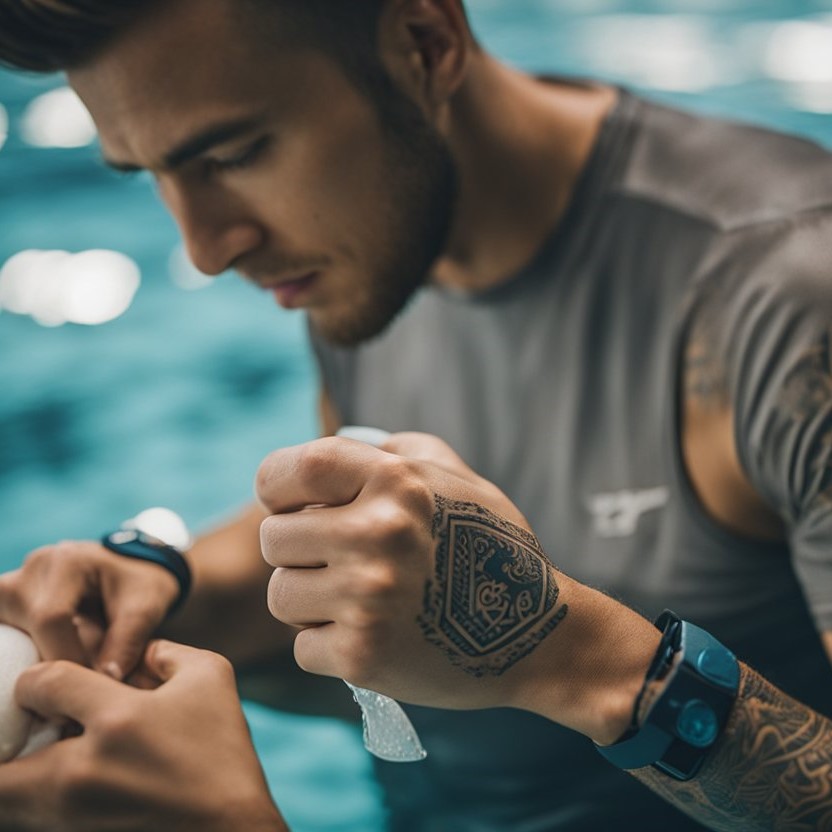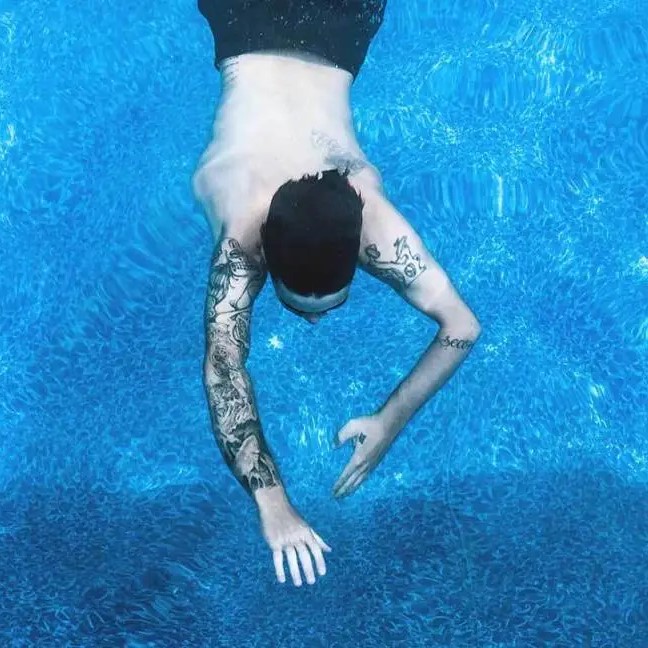Can you go swimming after getting a tattoo? This is one of the most common questions people ask after inking their skin. The short answer is no—not right away. Fresh tattoos are open wounds. They require proper care to avoid infection, fading, and poor healing. Water, especially from pools, lakes, or oceans, contains bacteria and chemicals that can damage your new artwork.
Moreover, submerging a healing tattoo can lead to serious complications. Chlorine, salt, and microorganisms may irritate the skin. This delays recovery and affects the final appearance.
In addition, tattoo artists universally advise against swimming during the first two to four weeks. This critical phase is when the skin forms a protective layer. Interrupting it increases risks.
Furthermore, even clean bathwater or hot tubs pose threats. Stagnant or heated water creates ideal conditions for bacteria. Soaking is not recommended.
However, showering is allowed. Quick, lukewarm showers with mild soap are safe. Just avoid direct spray and long exposure.
Consequently, timing matters. You must wait until your tattoo fully closes and scabs fall off naturally. Only then can you consider swimming.
Therefore, understanding the healing process is essential. This guide will help you protect your tattoo while staying active and safe.
 Why Swimming Too Soon Damages a Fresh Tattoo
Why Swimming Too Soon Damages a Fresh Tattoo
Swimming too soon after getting a tattoo can cause significant damage. First, water softens the scabbing skin. This makes it easier to peel or scrub off accidentally. Losing scabs early leads to patchy ink loss.
Also, chlorine in pools dries out the skin. It strips natural oils and disrupts the healing barrier. This increases redness, itching, and cracking.
Saltwater from oceans pulls moisture from the wound. It can dehydrate the area and cause tightness. This leads to premature flaking.
Natural bodies of water like lakes and rivers carry bacteria. These include Pseudomonas and Staphylococcus. They can enter through the open skin. Infections may require medical treatment.
Additionally, warm water in hot tubs or saunas opens pores. This allows contaminants to penetrate deeper. Sweating in these environments worsens irritation.
Even sunscreen and swimsuits pose risks. Rubbing fabric irritates healing skin. Chemical sunblocks may cause allergic reactions.
Therefore, avoiding all types of water is crucial.
By waiting, you protect both health and appearance.
Hence, patience ensures your tattoo heals cleanly and lasts longer.
The Tattoo Healing Timeline and When It’s Safe to Swim
Understanding the tattoo healing timeline helps answer, “can you go swimming after getting a tattoo?” Most tattoos take two to four weeks to heal on the surface. However, deeper layers may need up to six weeks.
The first 48 hours are critical. The skin is raw and oozes plasma and ink. Keep it clean and covered if advised. Avoid all water during this phase.
Days 3 to 7 bring peaking inflammation. The tattoo feels sore, warm, and tight. Scabs begin to form. Do not soak or swim.
Week 2 involves itching and flaking. Skin starts shedding like a sunburn. Scratching damages ink. Water exposure weakens the new layer.
By week 3 or 4, most scabs fall off. The skin may look dry or slightly shiny. This signals surface healing.
Only now can you consider swimming. But first, confirm all flaking has stopped. The skin should feel smooth and closed.
Even then, ease into it. Start with short dips in clean, chlorinated pools. Avoid lakes or oceans until fully healed.
Use waterproof sunscreen after healing. Reapply every two hours.
Thus, timing and observation guide your return to water.
When in doubt, wait longer. It’s better to miss one swim than ruin a tattoo.
 What Types of Water Are Most Harmful to a Healing Tattoo?
What Types of Water Are Most Harmful to a Healing Tattoo?
Not all water is equally dangerous, but most types pose risks during healing. Chlorinated pool water ranks high on the threat list. Chlorine kills germs but also irritates healing skin. It dries the surface and delays recovery.
Saltwater is another major concern. While natural, it’s harsh on open wounds. Ocean water pulls moisture from the skin. This causes cracking and ink loss.
Moreover, seawater contains bacteria and pollutants. Runoff, boat fuel, and microplastics increase infection risks. Waves and sand can rub against the tattoo. This creates physical damage.
Freshwater bodies like lakes, rivers, and ponds are often worse. They harbor unseen bacteria, parasites, and algae. Leptospirosis and MRSA are real dangers.
Hot tubs and saunas create steamy, moist environments. These promote bacterial growth. Sitting in warm, dirty water is especially risky.
Even bathtubs are unsafe. Standing water collects germs. Sponges and bath salts may irritate sensitive skin.
Puddles and splash pads are no exception. Public play areas attract kids and animals. Germs spread easily.
Therefore, avoid all submersion until fully healed.
Showers are the only safe water exposure early on.
By recognizing these risks, you protect your tattoo investment.
How to Protect Your Tattoo If You Must Be Near Water
Sometimes, avoiding water isn’t possible. Maybe you’re on vacation or have outdoor plans. If so, protect your tattoo with smart strategies.
First, wait at least ten days. Let the worst of the healing pass. Never go in if the tattoo is still oozing or scabbing.
Use a waterproof tattoo cover. These adhesive films create a barrier. Brands like Saniderm or Tegaderm shield against water and dirt. Apply before entering any wet area.
Avoid direct immersion. Wading or sitting by the water is safer than swimming. Limit exposure time.
Wear loose clothing over the tattoo. Light, breathable fabrics reduce friction. They also block sun and bacteria.
Rinse with fresh water after any water contact. Use clean, lukewarm water and mild soap. Pat dry gently—do not rub.
Apply aftercare cream as needed. Use fragrance-free, non-petroleum-based lotions. Keep the skin moisturized but not greasy.
Wash hands before touching the tattoo. Germs from fingers cause infections.
Check the area often. Look for redness, swelling, or pus. These are signs of trouble.
Ultimately, prevention beats treatment.
If healing seems off, delay swimming.
Your tattoo will thank you later.
 Alternatives to Swimming While Your Tattoo Heals
Alternatives to Swimming While Your Tattoo Heals
You don’t have to miss out on summer fun while your tattoo heals. Many water-adjacent activities let you stay cool without risking damage.
For example, relax in the shade near the pool. Bring a chair, book, and cold drink. Enjoy the breeze without getting wet.
Take walks along the beach. Stick to dry sand. Wear loose clothing to protect the tattoo from sun and wind.
Try paddleboarding or kayaking. These let you enjoy water views. Sit above the surface. Avoid splashing or falling in.
Visit splash-free attractions. Zoos, museums, and parks offer fun for all ages. You can stay active and safe.
Host a backyard hangout. Use misting fans or shaded tents. Serve frozen treats to beat the heat.
Practice yoga or stretching outside. Light exercise promotes blood flow. This supports healing.
Use indoor pools for observation only. Watch others swim. Stay cool in air-conditioned spaces.
Even swimming in your mind helps. Visualize future swims with confidence.
These alternatives keep you engaged.
They also protect your healing tattoo.
Patience now leads to better results later.
Signs of Infection and When to See a Doctor
Even with care, complications can occur. Knowing the signs of infection helps you act fast.
Normal healing includes redness, swelling, and mild tenderness. These fade within a week. However, worsening symptoms need attention.
Watch for increasing pain. If the area feels hot, throbs, or becomes more sore, it may be infected.
Pus is a major red flag. Yellow or green discharge means bacteria are present. So is a bad smell.
Red streaks spreading from the tattoo suggest blood infection. This is serious. Seek help immediately.
Fever or chills accompany systemic infections. These require urgent care.
Swollen lymph nodes near the tattoo may also appear. This indicates the body is fighting illness.
Do not ignore early signs. Some people delay treatment. This leads to scarring or ink loss.
Clean the area gently. Use saline solution or mild soap.
Contact your tattoo artist first. They may offer advice.
Then see a doctor. Antibiotics may be needed.
Early action prevents long-term damage.
Your health is more important than any timeline.
 Professional Advice: What Tattoo Artists Recommend
Professional Advice: What Tattoo Artists Recommend
Tattoo artists consistently say: avoid water during healing. This advice comes from years of experience. They see what happens when clients ignore warnings.
Most studios require clients to sign aftercare sheets. These clearly state not to swim for at least two weeks. Some recommend up to four.
Artists stress that healing is a process. It’s not just about looks. It’s about skin health.
They suggest using fragrance-free ointments. Aquaphor or unscented lotion works well. Apply thin layers twice a day.
Avoid picking scabs. Let them fall off naturally. Scratching leads to scarring.
Keep the tattoo out of direct sun. UV rays fade ink. Use clothing as protection.
Touch-ups are common. Waiting ensures better results. Healing fully allows accurate assessment.
Communication matters. If unsure, text your artist a photo. Most respond quickly.
They care about their work. A healed tattoo reflects their skill.
Therefore, follow their guidance.
It protects your investment and health.
Frequently Asked Questions About Can You Go Swimming After Getting a Tattoo
Can I shower after getting a tattoo?
Yes. Use lukewarm water and mild soap. Keep it short. Avoid soaking or scrubbing.
How long after a tattoo can I swim in a pool?
Wait at least 2–4 weeks. Only go in if the skin is fully healed and closed.
Is it safe to swim in the ocean with a new tattoo?
No. Salt, sand, and bacteria increase infection and fading risks. Wait at least four weeks.
Can I go in a hot tub after getting a tattoo?
No. Hot tubs harbor bacteria and steam opens pores. Avoid for at least four weeks.
What if my tattoo gets wet accidentally?
Rinse with clean water. Pat dry gently. Apply aftercare. Watch for irritation.
Can I use a waterproof bandage to swim sooner?
Not recommended. Even sealed covers can leak. Water pressure forces entry.
How do I know when my tattoo is fully healed?
Scabs are gone. Skin feels smooth. No redness, oozing, or pain.
Will swimming ruin my tattoo forever?
It can cause fading, patchiness, or scarring. Prevention is key. Once damaged, it may need touch-ups.
 Summary: Can You Go Swimming After Getting a Tattoo?
Summary: Can You Go Swimming After Getting a Tattoo?
Can you go swimming after getting a tattoo? The answer is clear: not until it’s fully healed. Waiting protects your skin, ink, and health.
By avoiding pools, oceans, and hot tubs for 2–4 weeks, you ensure clean, vibrant results.
Even small exposures carry risks. Patience leads to better outcomes.
Use alternatives, follow aftercare, and listen to your artist.
Ultimately, a healed tattoo lasts a lifetime. A few missed swims are worth the wait.
So, protect your art. Enjoy the water later.
And always remember—can you go swimming after getting a tattoo? Only when your skin says yes.